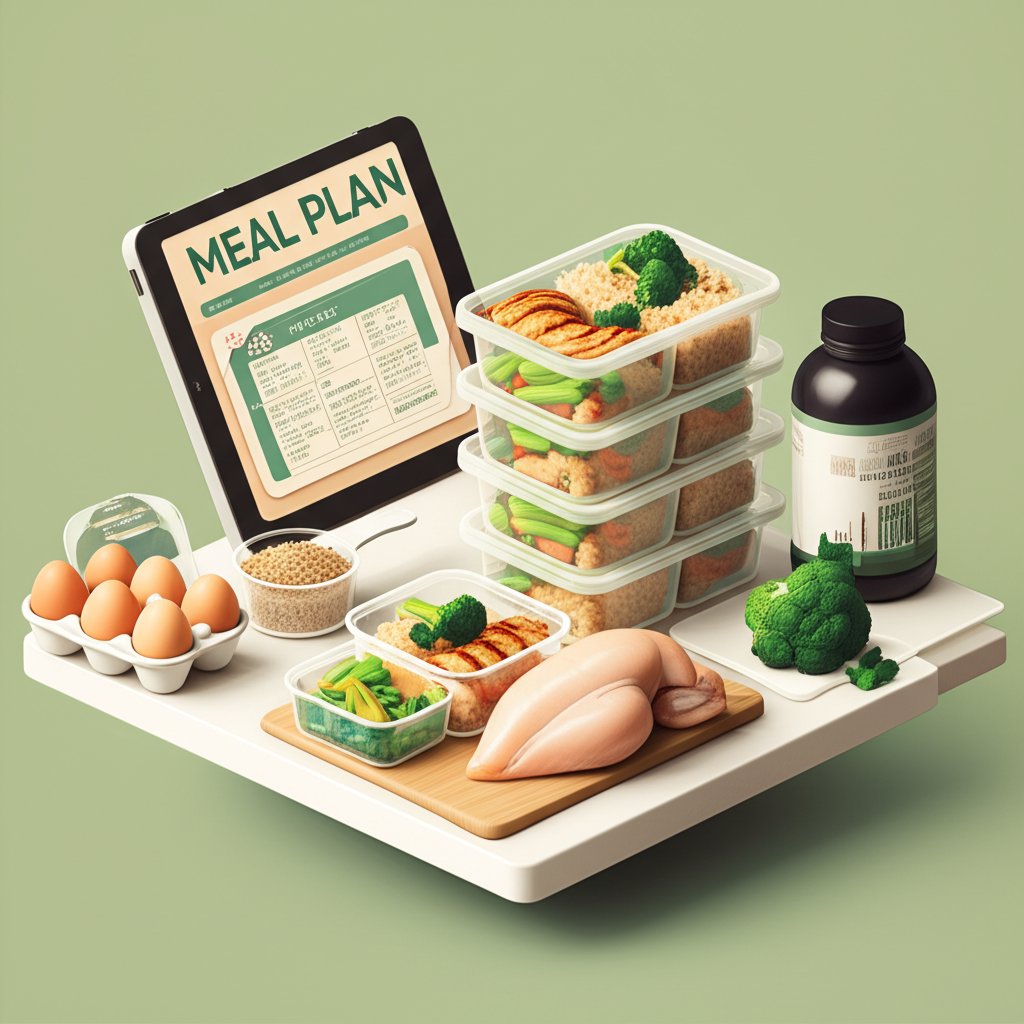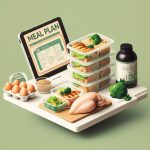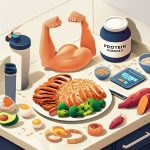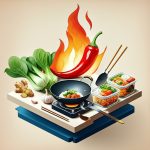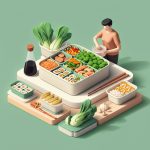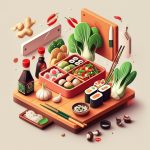Of course. Here is the detailed cluster article on bulking meal prep, crafted with the expertise and precision you requested.
Hitting the gym is only half the battle. The other half happens in the kitchen, and for anyone serious about gaining muscle, a solid bulking meal prep strategy is your secret weapon. Without a plan, you’re left scrambling for high-calorie meals, often defaulting to expensive takeout or snacks that don’t serve your goals. The right prep system transforms bulking from a constant, nagging chore into a streamlined process that guarantees you have the fuel you need, right when you need it.
This isn’t about endlessly eating boring chicken and rice. It’s about building a smart, efficient system to create delicious, macro-friendly meals that make gaining quality mass feel effortless.
At a Glance: Your Bulking Prep Blueprint
- The Core Principle: Understand why a strategic calorie surplus is non-negotiable for muscle growth.
- Choose Your Path: Decide between a “Clean Bulk” for lean gains or a “Dirty Bulk” for rapid mass.
- The 4-Step System: Learn a simple, repeatable framework for planning, shopping, cooking, and storing your meals.
- Sample Playbook: Get a practical weekly menu and a shopping list template you can adapt immediately.
- Smart Storage: Master the tips to keep your prepped food fresh, safe, and delicious all week long.
First, Define Your Bulking Philosophy

Before you fire up the stove, you need a clear strategy. Bulking simply means consuming more calories than your body burns, creating an energy surplus that your body can use to build new muscle tissue. But how you create that surplus matters immensely. There are two primary schools of thought.
Clean Bulking: The Sustainable Path to Lean Mass
A clean bulk focuses on a moderate calorie surplus (typically 300-500 calories above your maintenance level) derived from whole, nutrient-dense foods. Think lean proteins, complex carbohydrates, and healthy fats.
The goal is to provide your body with just enough extra energy to build muscle efficiently while minimizing fat gain. This is a more controlled, sustainable approach. It might not be as fast, but the quality of the weight you gain is significantly higher.
Dirty Bulking: The All-Out Approach to Gaining Weight
A dirty bulk involves a large calorie surplus, often with a “no-foods-barred” mentality. This includes high-calorie processed foods, fast food, and anything else that helps you hit a massive calorie target.
While you will certainly gain weight—and muscle—quickly, a significant portion of that gain will be body fat. This approach can be tempting for classic “hard gainers” who struggle to eat enough, but it often requires a tough “cutting” phase later to shed the excess fat. For most people, the health and aesthetic trade-offs aren’t worth it.
For a sustainable, long-term plan, the clean bulking approach is almost always the superior choice.
The 4-Step Framework for Effective Bulking Meal Prep
A successful bulking meal prep routine isn’t about having a dozen complex recipes. It’s about having a system. Follow these four steps to build a rock-solid foundation.
Step 1: Know Your Numbers (The Simple Way)
You can’t hit a target you can’t see. Start by getting a solid estimate of your daily calorie and macronutrient needs.
- Estimate Your Maintenance Calories: Use a reliable TDEE (Total Daily Energy Expenditure) calculator online. This will estimate how many calories you burn per day based on your age, weight, height, and activity level.
- Create Your Surplus: Add 300-500 calories to your TDEE. This is your daily bulking target. For example, if your TDEE is 2,700 calories, your bulking target will be 3,000–3,200 calories.
- Set Your Macros: A great starting point for muscle gain is a split of 40% protein, 35% carbohydrates, and 25% fat.
Let’s see this in action. An active 180-pound individual might have a TDEE of 2,800 calories. For a clean bulk, their target is ~3,200 calories. Based on our 40/35/25 split, that breaks down to:
- Protein: 320g (1,280 calories)
- Carbs: 280g (1,120 calories)
- Fat: 89g (800 calories)
Don’t get paralyzed by these numbers. They are a starting point. Track your progress for a few weeks and adjust as needed.
Step 2: Build Your Meal Matrix
This is where planning becomes easy. Instead of searching for full recipes, think in terms of components you can mix and match. Create a simple chart for your main meals.
| Meal | Protein Source | Complex Carb Source | Healthy Fat Source | Vegetables |
|---|---|---|---|---|
| Lunch | Grilled Chicken Breast | Quinoa | Avocado Slices | Spinach, Tomato |
| Dinner | Baked Salmon Fillet | Sweet Potato | Olive Oil Drizzle | Roasted Asparagus |
| Snack | Greek Yogurt | Oats (in yogurt) | Chia Seeds | Berries |
| This modular approach prevents food boredom and makes grocery shopping incredibly simple. You’re not buying ingredients for one specific recipe; you’re buying versatile staples. This system is the backbone for creating varied meals, and you can find a ton of inspiration in our comprehensive guide to Delicious Bulking Lunch Recipes. |
Step 3: The “Shop and Chop” Session
Efficiency is key. Dedicate one block of time—usually Sunday afternoon—to get everything ready for the week ahead.
- Shop with a List: Group your grocery list by store section: Produce, Proteins (butcher/deli), Pantry (grains, cans), and Dairy/Frozen. This prevents backtracking and saves time.
- Batch Cook Your Staples: This is the most important part. Get all your core components cooked at once.
- On the Stovetop: Cook a large batch of quinoa and another of brown rice.
- In the Oven/On the Grill: Bake or grill a week’s worth of chicken breasts and salmon fillets. Roast trays of sweet potatoes, broccoli, and asparagus.
- On the Counter: Chop raw veggies like bell peppers and onions. Wash and dry leafy greens like spinach.
By the end of this session, you should have a collection of cooked ingredients, not finished meals. This gives you flexibility.
Step 4: Assemble and Store Like a Pro
Now, you simply assemble your meals for the next few days.
- Portion Control: Use a food scale to portion your cooked ingredients into meal prep containers according to your macros. It might feel tedious at first, but it quickly becomes second nature and ensures you’re actually hitting your targets.
- Fridge vs. Freezer: Store meals for the next 3-4 days in the refrigerator. Anything beyond that should go into the freezer to maintain freshness and safety.
- What Freezes Well: Most cooked meats, grains (rice, quinoa), stews, and chilis freeze perfectly.
- What Doesn’t: Fresh salads, dairy-heavy sauces (they can separate), and raw vegetables with high water content (like cucumbers). Keep sauces and dressings separate until you’re ready to eat.
A Sample Bulking Meal Prep Playbook
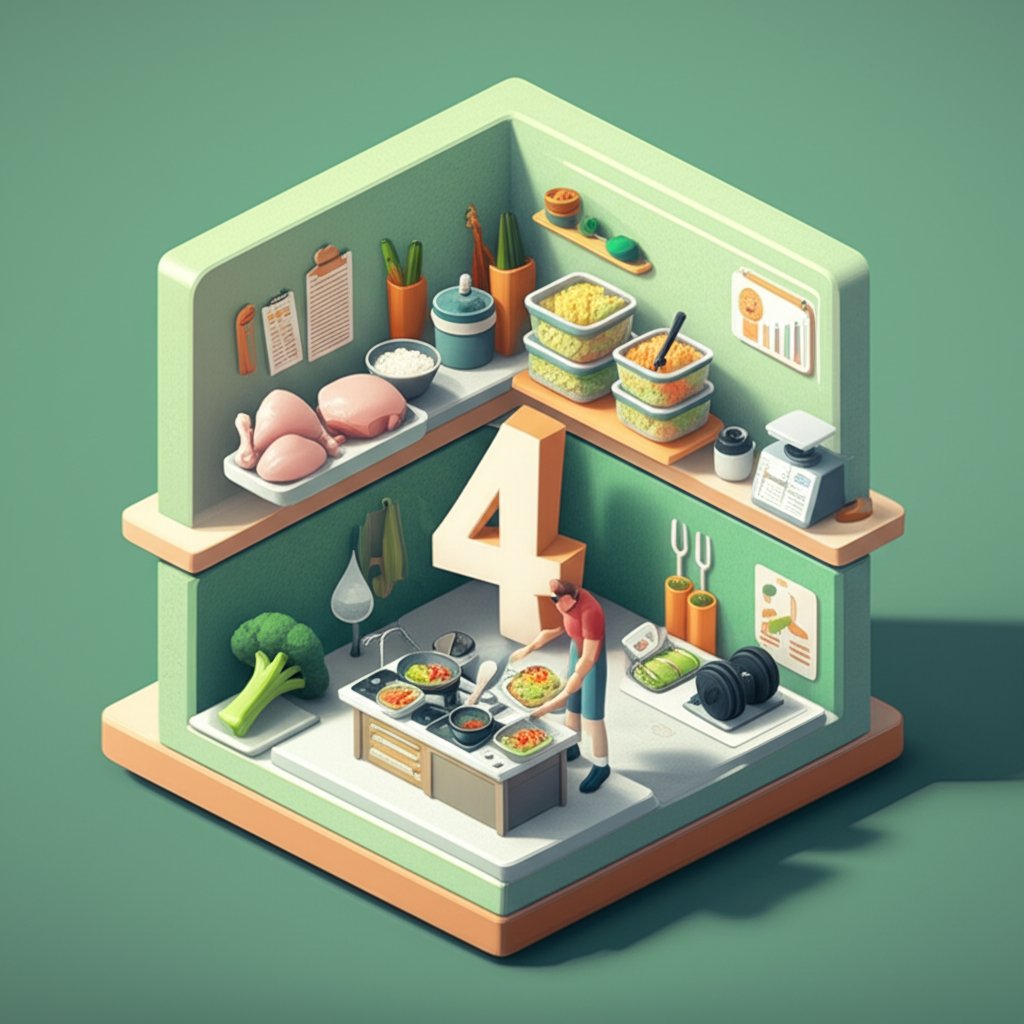
Let’s put this system into a concrete example for a week.
Your Weekly Shopping List Blueprint
- Proteins: 4 lbs chicken breast, 1 lb salmon fillet, 1 lb lean ground beef (90/10), dozen eggs, Greek yogurt, vanilla protein powder.
- Complex Carbs: Quinoa, brown rice, sweet potatoes, whole-wheat tortillas, rolled oats.
- Healthy Fats: Avocados, olive oil, almonds, peanut butter, chia seeds.
- Fruits & Veggies: Spinach, broccoli, asparagus, bell peppers, onions, bananas, mixed berries.
Your Sunday Prep Session (90-Minute Workflow)
- Preheat Oven to 400°F (200°C).
- Grains: Get a large pot of quinoa and a pot of brown rice cooking on the stovetop.
- Veggies & Potatoes: Chop sweet potatoes, broccoli, and asparagus. Toss with olive oil, salt, and pepper. Spread on baking sheets and place in the oven.
- Proteins: While veggies roast, season and grill or pan-sear the chicken breasts and salmon. In a separate pan, brown the ground beef with chopped onions and peppers.
- Cool & Portion: Once everything is cooked, let it cool slightly. Then, begin your assembly line, portioning out meals into containers. For example:
- Meal 1 (x3): 6oz chicken, 1 cup quinoa, 1 cup roasted broccoli.
- Meal 2 (x3): 6oz ground beef, 1 cup brown rice, 1/2 cup sautéed peppers/onions.
- Meal 3 (x2): 6oz salmon, 1 cup roasted sweet potato, 1 cup roasted asparagus.
In about 90 minutes, you’ve prepped over half your lunches and dinners for the entire week.
Answering Your Top Bulking Meal Prep Questions
Even with a solid plan, questions come up. Here are the most common ones.
Q: How do I avoid eating the same boring meal every day?
A: Variety comes from sauces, seasonings, and assembly. Prep components, not identical meals. A batch of grilled chicken can become a chicken power bowl on Monday, part of a chicken wrap on Tuesday, and get tossed with a spicy peanut sauce on Wednesday. The research highlights homemade seasonings like “Spicy Taco Seasoning” or sauces for a “Beef Teriyaki Noodle Stir-Fry” as great ways to add flavor without excess calories or preservatives.
Q: Isn’t bulking meal prep expensive?
A: It’s an investment that pays off. Buying ingredients like chicken, oats, and rice in bulk is far cheaper per meal than buying lunch every day. A single takeout meal can cost $15-$20, while a prepped meal often comes in under $5. You also eliminate food waste by planning exactly what you need.
Q: How long does prepped food last in the fridge?
A: The standard guideline for most cooked meals is 3-4 days in the refrigerator. For a 7-day prep, you should plan to eat the meals for days 1-4 from the fridge and freeze the meals for days 5-7. Simply move a frozen meal to the fridge the night before you plan to eat it.
Q: I’m a vegetarian/vegan. Can I still do a bulking meal prep?
A: Absolutely. The principles are identical—you just swap the protein sources. Your staples will include tofu, tempeh, seitan, lentils, chickpeas, and beans. For example, a “Crispy Tofu & Teriyaki Noodles” meal provides 462 calories and 17g of protein per serving, while a “Vegan Lentil Bolognese” packs 486 calories and 21g of protein. The key is to ensure you’re combining sources to get a complete amino acid profile.
Your First Bulking Meal Prep: A Quick-Start Guide
Feeling overwhelmed? Don’t be. You don’t have to go from zero to a full 7-day prep overnight. Start small to build momentum.
- Pick Two Recipes: Choose just ONE lunch and ONE breakfast to prep for the next three days. A great combo is the Grilled Chicken and Quinoa Power Bowl for lunch and Overnight Oats with Protein Powder and Chia Seeds for breakfast.
- Make a Mini-List: Write a focused grocery list for only those ingredients.
- Block 60 Minutes: Find one hour this weekend. Use it to cook the chicken and quinoa and mix three jars of overnight oats.
- Enjoy the Freedom: Notice how much mental energy and time you save on Monday, Tuesday, and Wednesday. You’ll have delicious, goal-oriented meals ready to go.
This small win will build the confidence to scale up to a full week. Bulking meal prep is a skill, and like any skill, you get better with practice. Start now, stay consistent, and watch your efforts in the gym pay off on your plate.
- Easy Bulking Meal Prep to Fuel Your Muscle Gains - November 13, 2025
- Bulking Lunch Recipes that Make Muscle Gain Delicious - November 12, 2025
- Simple Asian Meal Prep Recipes to Spice Up Your Week - November 11, 2025
